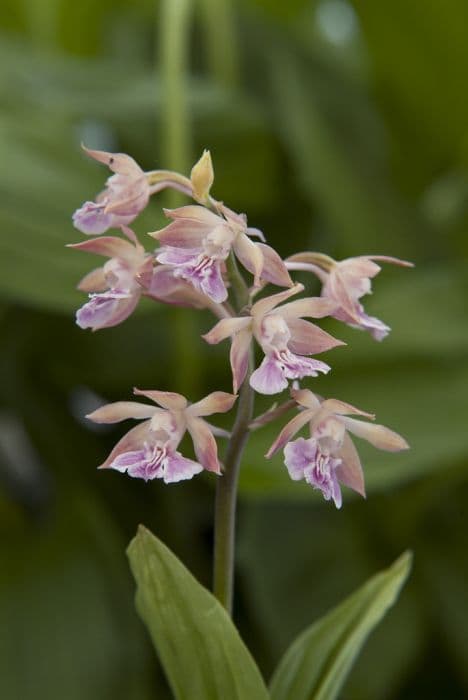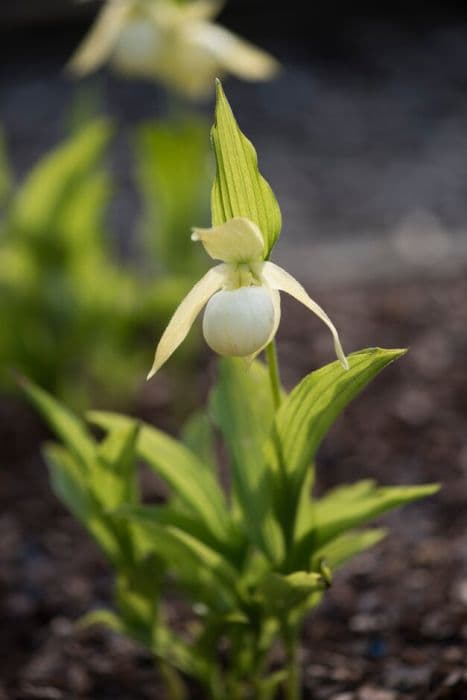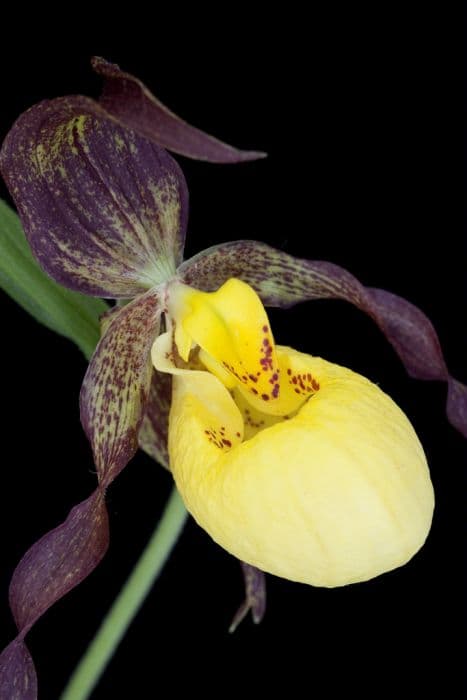Ebine Calanthe discolor

ABOUT
Calanthe discolor, often referred to as the Japanese Calanthe, is a terrestrial orchid that displays a lush, elegant look. Its foliage is striking, with pleated leaves that add a textural quality to its presentation. The leaves are typically a rich green color, contributing to the dense, verdant appearance of the plant. During its blooming season, this orchid produces a handsome floral display, showcasing a stalk that bears numerous flowers. These blossoms are characterized by a unique shape that's typical of many orchid species, with petals and sepals that can range in color from whites and yellows to purples and pinks, often complemented by contrasting lips which may be spotted or streaked. The overall impression of the Japanese Calanthe is one of refined beauty and complexity, cherished by enthusiasts for its ornate blooms and attractive foliage.
About this plant
 Names
NamesFamily
Orchidaceae
Synonyms
Japanese Calanthe, Ebine
Common names
Alismorkis discolor, Calanthe amamiana, Calanthe discolor f. amamiana, Calanthe discolor f. sieboldii, Calanthe izu-insularis, Calanthe makinoi, Calanthe sieboldii, Calanthe sieboldii Decne. ex Regel, Calanthe striata var. discolor, Calanthe striata var. sieboldii, Eburophyton sieboldii, Limodorum discolor.
 Toxicity
ToxicityTo humans
The Calanthe discolor, commonly known as the Japanese Calanthe, does not have a widespread reputation for being poisonous to humans. While there might be individual sensitivities or allergic reactions in some people after handling or ingesting the plant, standard references do not typically list this species as a toxic plant with known symptoms of poisoning. However, it is always prudent to avoid ingesting any part of a plant not known to be safe for consumption, as it could lead to gastrointestinal discomfort or other adverse effects in sensitive individuals.
To pets
The Calanthe discolor, commonly known as the Japanese Calanthe, is not commonly listed as a toxic plant to pets, such as cats and dogs. However, pets may experience individual sensitivities or gastrointestinal upset if they ingest parts of the plant. There are no specific documented symptoms of poisoning for the Japanese Calanthe in pets, but as a general rule, it is advisable to prevent pets from ingesting plants that are not confirmed to be safe to reduce the risk of potential negative reactions.
 Characteristics
CharacteristicsLife cycle
Perennials
Foliage type
Deciduous
Color of leaves
Green
Flower color
Pink
Height
1 foot (30 cm)
Spread
1 foot (30 cm)
Plant type
Herb
Hardiness zones
6
Native area
Japan
Benefits
 General Benefits
General Benefits- Ornamental Value: Calanthe discolor, commonly known as ebine orchid, adds aesthetic appeal to gardens with its attractive foliage and distinct flowers.
- Low Maintenance: Ebine orchid is known for being relatively easy to care for, requiring minimal attention once established in a suitable environment.
- Shade Tolerance: This plant thrives in shaded areas, making it an excellent option for garden spots that receive less sunlight.
- Seasonal Interest: It blooms in the spring, providing seasonal interest and enhancing the garden's visual appeal during this time.
- Drought Resistance: Once established, ebine orchid can tolerate periods of dryness, making it suitable for gardens with drier conditions.
- Cold Hardiness: It is capable of withstanding cooler temperatures, which allows it to be grown in a variety of climates.
- Wildlife Attraction: The flowers of the ebine orchid can attract pollinators such as bees, contributing to the health of the garden ecosystem.
- Versatility: This plant can be cultivated both in the ground and in containers, offering flexibility in garden design and plant placement.
- Groundcover Potential: Ebine orchid can serve as groundcover in suitable garden zones, helping to suppress weeds and stabilize soil.
 Medical Properties
Medical Properties- This plant is not used for medical purposes.
 Air-purifying Qualities
Air-purifying QualitiesThis plant is not specifically known for air purifying qualities.
 Other Uses
Other Uses- Calanthe discolor, commonly known as the Japanese Ebony Orchid, has leaves that can be used in flower arrangements for their decorative foliage, which remains attractive even when the plant is not in bloom.
- The pseudobulbs of the Japanese Ebony Orchid can be incorporated into botanical jewelry and craft for their unique shape and texture, often after being dried.
- As a ground cover in shady gardens, Japanese Ebony Orchid can provide a lush, green carpet due to its clumping nature.
- In traditional Japanese gardens, Japanese Ebony Orchid is appreciated for its seasonal appeal, marking the progression of spring with its flowering.
- The plant is sometimes used in educational settings, like botany classes, to illustrate the lifecycle and reproductive systems of terrestrial orchids.
- Japanese Ebony Orchid has been used in cultural festivals and events in Japan, symbolizing the arrival of spring and natural beauty.
- Culinary experimentation has seen the use of Japanese Ebony Orchid’s flowers as edible decorations on dishes for their aesthetic appeal, although they are not commonly eaten.
- The hardy nature of Japanese Ebony Orchid makes it suitable for use in mixed-species plant terrariums, mimicking its native understory habitat.
- Artists and photographers frequently use Japanese Ebony Orchid as a subject due to its striking flowers and the challenge of capturing its detailed structure.
- Japanese Ebony Orchid plays a role in conservation efforts, being cultivated to reduce pressure on wild populations and maintain biodiversity.
Interesting Facts
 Feng Shui
Feng ShuiThe Japanese orchid is not used in Feng Shui practice.
 Zodiac Sign Compitability
Zodiac Sign CompitabilityThe Japanese orchid is not used in astrology practice.
 Plant Symbolism
Plant Symbolism- Perseverance and Determination: Native to Japan, Calanthe discolor, commonly known as Ebine Orchid, often blooms in challenging conditions, symbolizing the ability to overcome obstacles.
- Elegant Beauty: The Ebine Orchid's graceful appearance represents refined beauty, suggesting that the wearer or recipient possesses a delicate, sophisticated charm.
- Longevity: As a hardy perennial, the Ebine Orchid conveys wishes for a long and healthy life, making it a suitable gift for elders or in celebrations of significant milestones.
- Rare and Unique: Given its specific habitat requirements and unique flowering traits, the Ebine Orchid symbolizes uniqueness and rarity, celebrating the one-of-a-kind nature of an individual or relationship.
 Water
WaterThe Calanthe discolor, commonly known as the ebony orchid, requires consistent moisture, so water it when the top inch of soil feels dry. Aim to water approximately once a week, depending on environmental conditions, providing about 16 ounces of water each time. During the active growing season in spring and summer, you may need to water more frequently, while in fall and winter less often as growth slows down. Be sure not to let the plant sit in water as this can lead to root rot. It's best to water the ebony orchid in the morning to allow any excess moisture on the leaves to evaporate during the day.
 Light
LightThe ebony orchid thrives in bright, indirect light. It should be placed in a spot where it will receive filtered sunlight, such as near a north or east-facing window. Avoid direct sunlight, especially in the hot afternoon, as it can scorch the delicate leaves of the Calanthe discolor.
 Temperature
TemperatureThe ebony orchid prefers cooler temperatures, with an ideal range of 60 to 70 degrees Fahrenheit. It can tolerate a minimum temperature of about 50 degrees Fahrenheit and a maximum of around 80 degrees Fahrenheit. Keep the Calanthe discolor away from drafts and sudden temperature changes to ensure optimal growth.
 Pruning
PruningPruning the ebony orchid is generally done to remove dead or yellowing leaves and spent flower spikes to encourage healthy growth and improve aesthetic appearance. Prune after blooming, typically cutting back the flower spikes at the base. Pruning can be done as needed throughout the year, but is most effective after the plant has finished flowering.
 Cleaning
CleaningAs needed
 Soil
SoilThe best soil mix for Ebine (Calanthe discolor) is rich, well-draining, and moisture-retentive, with a pH of around 5.5 to 6.5. A blend of sphagnum peat moss, fine bark, and perlite in equal parts works well to satisfy the plant's needs.
 Repotting
RepottingEbine (Calanthe discolor) should be repotted every one to two years or when the potting mix begins to break down or the plant outgrows its pot, to ensure the health and vigor of the orchid.
 Humidity & Misting
Humidity & MistingEbine (Calanthe discolor) thrives best in humidity levels between 50% and 70%, mimicking its native woodland environments, and requires consistent moisture in the air.
 Suitable locations
Suitable locationsIndoor
Grow Ebine indoors with bright, indirect light and high humidity.
Outdoor
Plant Ebine outdoors in dappled shade with moist, rich soil.
Hardiness zone
6-9 USDA
 Life cycle
Life cycleThe life cycle of the Japanese Calanthe, Calanthe discolor, begins as a seed, typically dispersed by the wind due to its lightweight and small size. Once the seed lands in a suitable moist and shaded location, it germinates, a process that can be challenging without a mycorrhizal partner since Calanthe species often depend on symbiosis with fungi for nutrients. Following germination, the seedling develops into a small plant with a rosette of leaves at the ground level. The plant then grows a pseudobulb that serves as a storage organ, ensuring its survival through seasonal changes. As the Japanese Calanthe matures, it develops a flower stalk that bears multiple intricate flowers, usually in the spring. After pollination, which is often carried out by insects, the plant will produce seed capsules, and when mature, they release seeds to start the next generation.
 Propogation
PropogationPropogation time
Spring to Summer
Calanthe discolor, commonly known as the Japanese calanthe, is propagated chiefly through division, which is most effectively done in the spring as new growth begins. To propagate by division, carefully lift the plant from the soil and use a sharp knife to divide the pseudobulbs, ensuring that each division has at least one growth eye or shoot. These divisions should then be replanted in well-draining soil at the same depth they were growing initially, spaced approximately a foot apart (about 30 centimeters). Water the new plantings thoroughly and maintain even moisture without overwatering to encourage rooting and growth. This method of division helps to manage the size of the clump, rejuvenate older plants, and produce new plants that are genetically identical to the parent, thus preserving any desirable traits.









